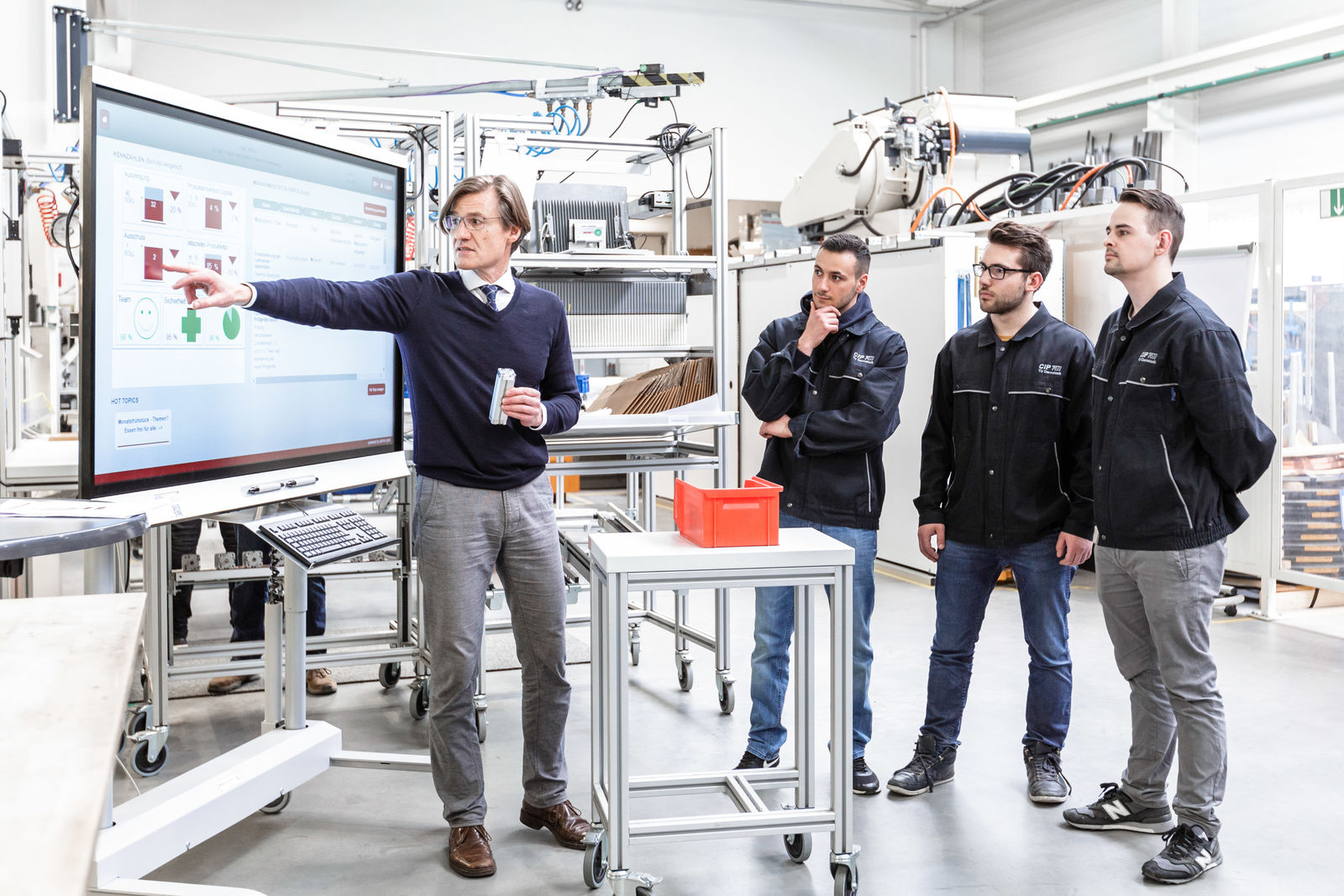Over the last decade, more than 2,000 employees of industrial organizations have taken advantage of the educational and vocational training opportunities at Germany's Technische Universität Darmstadt – where they learn about topics like Industry 4.0, digitalization and production efficiency and develop strategies for implementation. We spoke with research associates Jens Hambach and Andreas Wank and master's student Jonas Lauer to find out how Germany's SMEs are progressing in their digital transformation and where they still see room for improvement.

What is it that your participants from industrial companies are hoping to learn here?
Hambach: Everyone's talking about Industry 4.0 and digitalization, but there is still a great deal of uncertainty about what it all means in practice. Many companies are therefore turning to us for an overview of what their options are and to figure out where to take their first steps toward Industry 4.0 and digitalization.
In your experience, what is the most commonly held misconception?
Hambach: Many participants arrive thinking in buzzwords like cyber-physical systems, Internet of Things, machine learning and digital twins. These are high-profile concepts that pique people's interest and sensitize decision-makers to the issues at hand. In that way it is a positive thing – but, in the end, these are only instruments. If your entire strategy is aimed blindly at implementing specific technologies, it will generally not be effective. Our advice is to take a more methodical, benefits-based approach that starts with defining exactly what improvements can be made in your manufacturing process.
Are Germany's SMEs lagging behind in Industry 4.0 implementation?
Wank: Companies with under 250 employees really haven't made too much progress so far. Those with up to 2,000 employees have already invested substantially in digitalization, yet these investments have generally taken the form of isolated solutions dedicated to certain areas of the company. Now is the time to join these solutions together. Widening the focus from individual use cases to comprehensive solution sets makes it possible to leverage the benefits throughout the value stream. That is where we see the most room for improvement.
What does that mean, exactly?
Hambach: Companies have a variety of systems that they couldn't replace in the short term, even if they wanted to. From ERP systems to older equipment and numerous isolated sensors and instrumentation. In the course of our "Efficient Factory 4.0" project, we got to experience first hand the kinds of obstacles that can pop up when we tried to access data from a lathe that had been built in 2005. The controller didn't allow direct access to the machine data, and the manufacturer wanted €20,000 for the upgrade. For us, as would also be the case for many SMEs, this was simply not a viable solution. So we took a step back and asked ourselves what data we really needed for the task at hand. Then we set about finding a solution that would allow us to read and process that data, and that could be linked with our other systems to form a comprehensive solution. That was when APROL showed up on our radar.
And it turned out to be the solution you were looking for?
Wank: Yes, it did. One of the reasons was its scalability. That enables us to implement and expand Industry 4.0 capabilities step by step. APROL is also equipped with a broad selection of standard interfaces, including OPC UA and ODBC. That makes it possible to integrate OT and IT systems quickly and consistently at all levels. At the same time, APROL allows us to implement our own interfaces or use open-source components and integrate them seamlessly. That's how we implemented a REST API in Python, for example, which APROL treats like one of its own components. The process control system's flexibility and extensive range of interfaces also make it easy to integrate into both new and existing plants.
How do you get data out of a machine that – like the lathe you mentioned – doesn't have one of the supported standard interfaces?
Hambach: That was a matter of a few simple modifications. For example, we added a small adapter between a sensor and the machine controller that grants us bidirectional access to a fill level sensor. That way we can read live measurements without having to go through the controller. Based on this, we were able to implement a function that notifies the machine operator whenever it is necessary to refill the lubricant. We also tap into signals directly in the control cabinet. This is where another advantage of the B&R solution comes into play. Since the hardware and software is all from the same source and APROL is recognized automatically, there is no additional programming required.
How does APROL help companies make real progress toward Industry 4.0 in areas like condition monitoring?
Lauer: By serving as a platform for a wide range of applications, APROL makes it much easier to implement all sorts of Industry 4.0 capabilities. In the case of condition monitoring, the process control system offers a special function block that works optimally with a corresponding analog input module – the X20CP4810 – which executes the Fourier transform needed for vibration analysis.
Can you give us an example of how that works?
Lauer: We used these features to digitalize an old band saw with a pushbutton controller and equip it with a condition monitoring system. The band saw can be made to simulate various conditions for demonstration purposes. Even with a low-cost condition monitoring solution that only reads the infeed pressure, it's possible to deduce the health of the saw blade and saw head. By equipping the machine with additional sensors, we're able to identify an even wider range of conditions with even greater precision. We hooked up the sensor data to a neural network that is able to recognize correlations that humans could hardly notice. With this data, APROL is able to do things like tell the ERP system which machine is ready for a new order and whether the current saw blade will be able to handle the job. As a local data node, we use a small controller from B&R's X20 system. Its integrated OPC UA interface makes it especially easy to connect to APROL and other higher-level systems. With this approach, companies can generate added value – even on machines that play a relatively small role in value creation.
Does the neural network run within the APROL system?
Lauer: So far, we have been building the neural networks with the MATLAB simulation tool. That is, we record all the sensor data with MATLAB, analyze it, and then process the results into a neural network – which in turn calculates the parameters that we need. In principle, however, it would also be possible to program a neural network in Python and then integrate it seamlessly into APROL, like the REST API we mentioned.
APROL can be installed on virtual machines for cloud applications. Do you use this capability for added connectivity?
Wank: Yes, we use APROL in a private cloud. There we have an encrypted SQL database that holds process-relevant data from the APROL traceability system. This database can be accessed by other systems, such as our shop floor management system, which is located in a public cloud so that interested companies can hook up to it as easily as possible. In the long term, we'd like to bring the management system back on-site in a private cloud on a dedicated computer. Then we'll be able to decide which data to keep in our own production system and which to send to a public cloud.
 | Jens Hambach Research Associate, TU Darmstadt "An Industry 4.0 strategy aimed blindly at implementing specific technologies will generally not be effective. Our advice is to take a more methodical approach that starts with defining specific improvements that can be made in your manufacturing process." |
 | Andreas Wank Research Associate, TU Darmstadt "APROL is equipped with a broad selection of standard interfaces, including OPC UA and ODBC. That makes it possible to integrate OT and IT systems quickly and consistently at all levels." |
 | Jonas Lauer Master's Student, TU Darmstadt "By serving as a platform for a wide range of applications, APROL makes it much easier to implement all sorts of Industry 4.0 capabilities. With this approach, companies can generate added value – even on machines that play a relatively small role in value creation." |